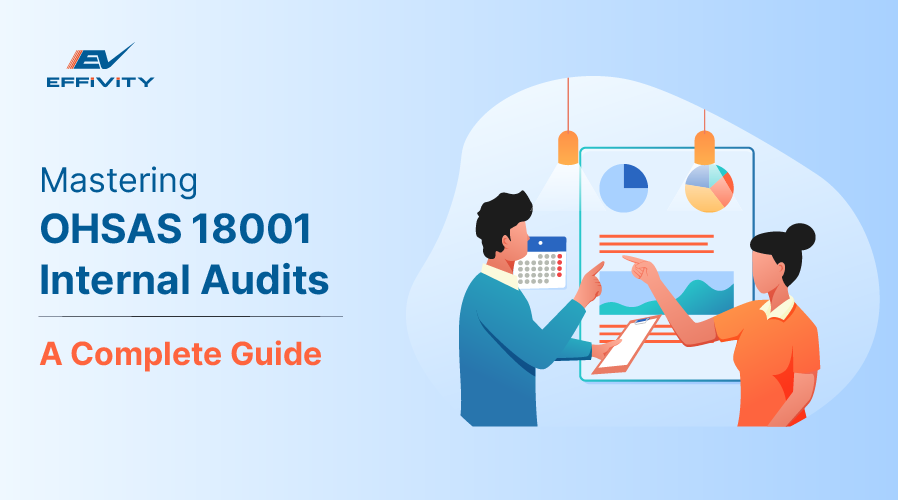Today, workplaces are constantly evolving, and the comfort and safety of employees are at the forefront of every organization's operation. Employees who feel safe in a workplace are known to contribute to the organization's growth more than those who don't. Workplace safety can also help you retain top talent and avoid severe legal pitfalls.
The OHSAS 18001 standard sets a global benchmark for occupational health and safety. It helps your organization create a safe working environment for your employees by focusing on internal audits and corrective measures.
In this article, we take a comprehensive look at OHSAS 18001 internal audits. Read for practical tips on planning and conducting audits for occupational health and safety management. You will also learn how to use the audit results to your advantage.
What is OHSAS 18001?
The OHSAS 18001 is a standard that helps organizations maintain occupational health and safety management systems. It gives you a framework to recognize, analyze control, and bring down the risks associated with health and safety in the workplace.
Key Elements of OHSAS
OHSAS 18001 outlines specific requirements for an effective OHSMS. These requirements help organizations develop policies, procedures, and controls to achieve their health and safety objectives. The OHSAS standard is built on the Plan-Do-Check-Act (PDCA) cycle. Some essential elements are:
-
Policy Development:
Establishing a clear health and safety policy. -
Planning:
Identifying hazards, assessing risks, and determining necessary controls. -
Implementation:
Developing capabilities and support mechanisms to achieve policy objectives. -
Evaluation:
Monitoring and measuring performance against the health and safety policy, objectives, and regulatory requirements. -
Improvement:
Corrective and preventive steps should be taken to improve the OHSMS continuously.
Internal Audits in the Context of OHSAS 18001
Internal audits are systematic, independent, and documented processes for obtaining audit evidence and analyzing it objectively. In the context of OHSAS 18001, internal audits assess whether the organization's OHSMS conforms to the planned benchmarks and the requirements of the standard.

Step 1: Planning and Scheduling OHSAS 18001 Internal Audits
A well-structured audit plan is essential for effective OHSAS 18001 internal audits. It ensures that audits are systematic, thorough, and aligned with your organization's health and safety objectives. Proper planning for health helps identify areas of risk, allocate resources efficiently, and avoid disruptions to normal operations. These are the criteria to create an audit schedule:
-
Frequency Based on Risk Assessments:
Prioritize audits based on the severity and likelihood of risks identified in your risk assessments. Higher-risk areas may need more frequent audits -
Incorporating Results from Previous Audits:
Use findings from past audits to determine focus areas. Re-audit areas with recurring issues to ensure corrective actions are effective. -
Adapting to Incidents, Accidents, and Stakeholder Input:
Be flexible with your audit schedule. Significant incidents or accidents may necessitate immediate audits. Consider stakeholder feedback to address their concerns promptly.
Best Practices for Scheduling Internal Audits
- Develop a yearly audit schedule with detailed timelines.
- Include both announced and unannounced audits to get an accurate picture of your OHSMS.
- Review and adjust the schedule regularly based on emerging risks and organizational changes.
Step 2: Selecting the Right Auditors
Selecting impartial and objective auditors is crucial for credible audit results. Auditors should have no conflicts of interest and should be independent of the areas they are auditing. Some aspects to consider in your choice are:
-
Experience and Qualifications:
Choose auditors with relevant experience in health and safety management. Qualifications such as certifications in OHSAS 18001 auditing add credibility. -
Familiarity with OHSAS Policy, Objectives, and Performance:
Auditors must understand your organization's OHSAS policy and objectives. They should be familiar with performance metrics to evaluate compliance effectively. -
Training and Certification Options:
Provide training opportunities to ensure auditors are up-to-date with the latest standards and auditing techniques. Certification programs can enhance their skills and knowledge.
Step 3: Preparing for the Internal Audit
Before the audit, gather all relevant information and documentation:
- Collect data from your latest risk assessments.
- Review findings and corrective actions from past audits.
- Ensure you have current performance data and objectives.
Then, create an audit checklist to guide your internal audit process. Identify critical areas such as compliance with legal requirements, risk management processes, and emergency preparedness. Be aware of common issues like incomplete records or overlooked hazards.
Involve stakeholders and employees in the preparation phase. Their input can highlight areas of concern and improve the audit's effectiveness.
Step 4: Performing the OHSAS 18001 Internal Audit
These are the processes you need to follow to complete an internal audit successfully:
-
Initial Meeting and Scope Definition:
Start with a meeting to define the audit's scope, objectives, and schedule. -
On-Site Activities and Data Collection:
Conduct on-site inspections, observe processes, and collect data. -
Interviews and Observations:
Interview employees and observe their activities to verify compliance. -
Document Review:
Review relevant documents to ensure they meet OHSAS 18001 requirements.
Techniques for Effective Auditing
- Root Cause Analysis can assist you with identifying the underlying causes of non-conformities.
- Risk Assessment Methodologies use established risk assessment techniques to evaluate hazards and controls.
Step 5: Analyzing Audit Findings and Reporting
After the audit is completed, you must compile the audit data and findings. Some steps to do this include:
-
Categorizing Non-Conformities and Observations:
Classify issues based on their severity and impact. -
Prioritizing Issues Based on Risk and Impact:
Focus on high-risk areas that require immediate attention. -
Structure and Key Components of the Report:
Include an executive summary, detailed findings, and recommended actions. -
Making Actionable Recommendations:
Provide specific, feasible recommendations for improvement. -
Effective Communication Strategies:
Use clear and lucid language to communicate the results to your management. Highlight key findings and their implications.
Step 6: Using Internal Audit Results for Continual Improvement
Internal audits are critical for ongoing improvement. They identify areas for enhancement and verify the effectiveness of implemented changes. Here's how you can implement corrective and preventive actions:
-
Developing Action Plans:
Create detailed plans with specific actions to address identified issues. -
Assigning Responsibilities and Timelines:
Assign tasks to responsible individuals with clear deadlines. -
Follow-Up Audits and Reviews:
Schedule follow-up audits to ensure problems are resolved. -
Metrics for Measuring Improvement:
Use performance metrics to evaluate the effectiveness of implemented changes.
Final Thoughts
Adopting best practices for OHSAS 18001 internal audits ensures your organization maintains a safe and compliant workplace. Regular training for auditors, thorough documentation, and an impartial approach are crucial elements of an effective audit process.
OHSAS 18001 is vital in promoting a culture of safety and continuous improvement. Internal audits are essential for identifying risks, verifying compliance, and driving health and safety performance enhancements.
Utilizing software solutions can streamline the audit process, providing tools for scheduling, data collection, and reporting. This technology ensures accuracy, efficiency, and effective management of your OHSAS 18001 system.






























